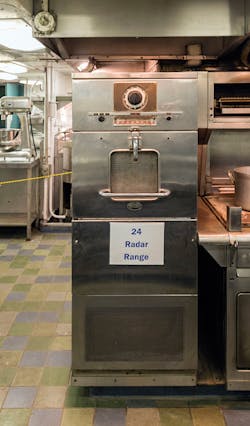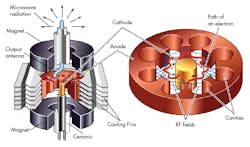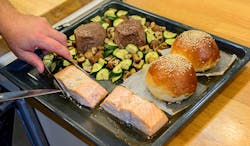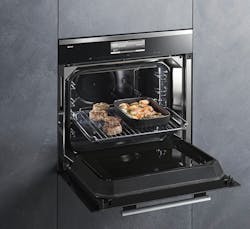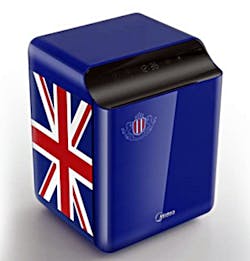Download this article as a .PDF
Silicon Valley may be the acknowledged birthplace of high-tech, but the microwave oven—arguably one of most useful products ever created—was developed in Waltham, Mass. It put Percy Spencer in the history books, although this master of the magnetron would’ve wound up there anyway with more than 150 patents to his credit.
Unfortunately, it’s the magnetron that has kept the microwave oven from becoming more than a way to make popcorn, defrost prepackaged foods, and reheat coffee. Fortunately, nearly three quarters of a century after Raytheon filed a patent covering Spencer’s invention (for which he received the company’s customary $2), the microwave oven is finally getting a thorough 21st Century overhaul.
Microwave ovens have come a very long way from the Amana Radarange that resulted from what (legend has it) was a candy bar melting in Spencer’s pocket while he was tweaking a powered-up magnetron. The first Radaranges were nearly 6 ft. high, weighed 750 lb., and cost about $5,000 ($54,000 in today’s dollars). They devoured 3 kW of power from 120 VAC, and had to be water cooled (Fig. 1).
1. A Raytheon Radarange was installed on the NS Savannah nuclear-powered cargo ship (now a museum ship) in 196.1 (Source: Wikipedia)
Today even a high-end microwave oven complete with fan-forced convection for crispy skin and assorted features like multiple cooking settings and a humidity sensor costs less than $500. The microwave oven state-of-the-art is exemplified by products like some from KitchenAid that also steam food based on its type and desired “doneness,” and use the steam to help remove stains from the oven as well. They even have an acoustic sensor that listens to the sound of popping corn and turns off the magnetron when its fully popped.
But they still can’t replace every type of cooking appliance, are too small to cook a turkey, heat unevenly, thaw foods disastrously, can cause a miniature firework display when a fork is left inside, steal moisture from food, and remove some of its original nutrients. In short, they don’t do a great job of either defrosting or cooking.
What It Takes to Be Better
Turning a microwave into a full-fledged, cooks-anything device requires more and different ingredients—namely replacing the magnetron with a solid-state RF power amplifier and adding a receiver, sculpting the RF energy into beams that can be directed to specific foods on the turntable, more modern sensor integration, and proficient software that can orchestrate the process and cook several types of food simultaneously without intervention from the “chef.” The result would be what the white goods and RF semiconductor industries like to call RF cooking, to reinforce that this is not simply a microwave oven. Browning would nevertheless still require an additional cooking method such as an electrical heating element.
Although the immense volume of microwave oven sales has reduced magnetron prices to the commodity level, they’re still the same inflexible RF power source they have always been. A magnetron (Fig. 2) has two RF power states, on and off, and there is no way to vary its RF output. Its frequency is not tunable at least intentionally (it tends to drift) and phase and amplitude cannot be accurately controlled. These limitations effectively make the device incapable of adjusting cooking parameters—and limit their performance in the radar systems they were originally designed for, which is in part why solid-state devices have taken their place.
2. The workings of a magnetron. (Source: Encyclopedia Britannica)
Defrosting is an excellent application illustrating the limitations of magnetrons for cooking. A magnetron-based oven basically blasts about 1 kW of energy into a cavity and “stirs” it to produce more uniform energy distribution. This energy cannot be varied, so defrosting is performed by turning the magnetron on and off. The result is that (for example) in a frozen hamburger patty, some portions will be fully defrosted, others fully cooked, and the rest somewhere in between.
In contrast, the power level of an amplifier powered by solid-state devices such as LDMOS RF power transistors can be infinitely varied, as can their frequency and phase, which along with real-time analysis of the food state is far more precise, resulting in uniformly-defrosted food. This same scenario applies equally to cooking, as faced with multiple items on a turntable, a magnetron-based oven will simply cook everything the same way (with predictable results).
The output of a magnetron also decreases time with time. This is rarely noticed in a home environment where a microwave oven is generally not the primary cooking appliance. However, commercial microwave ovens at fast-food restaurants operate almost continuously, as are those in the hundred-odd industrial applications ranging from curing wood to drying dog food.
In these applications, it’s not uncommon for a magnetron to be replaced twice a year, and while the device itself isn’t expensive, the truck roll definitely is. When multiplied by the thousands of restaurants in a major fast-food chain, each one having several ovens, the result is a noticeable impact on the bottom line. A solid-state oven will produce almost the exact same RF output power for its entire operating life, which is about 100 yr., while an industrial-grade magnetron has a lifetime of between 2,000 and 6,000 hr.
A reasonable question might be why, considering the enormous advantages of solid-state devices, have they not been used for RF cooking before. There are several reasons, the first of which being that until relatively recently have RF power transistors been rugged enough to withstand the varying load conditions encountered in cooking. They also didn’t have the overall performance characteristics.
Current LDMOS and most recently some gallium0nitride (GaN) RF power transistors meet all of these requirements, and can withstand impedance mismatches from 20:1 for GaN to 65:1 for LDMOS. Even though the RF cooking environment is comparatively well-controlled compared to applications like Magnetic Resonance Imaging, where LDMOS transistors are also used, it still presents challenges.
The ability to vary their RF output power level allows solid-state devices to provide much more precise application of energy, and as they are also frequency agile, solid-state RF power amplifiers can be tuned to the meet the conditions of the load (that is, the target material). These characteristics are essential, as cooking inherently produces widely varying loads caused by changes in the properties of the food during the cooking process.
In addition, by sweeping the frequency range of the output, hot and cold spots within the material can be uniformly targeted. The switch-mode power supplies for amplifiers based on LDMOS RF power transistors are also far smaller, more reliable, and operate at tens of volts versus the thousands of volts required by magnetrons. For a given RF output, a solid-state amplifier is typically half the weight of one using a magnetron, and unlike magnetrons there is no need for complex electromechanical controls and sequencing.
What’s Cooking
Israeli company Goji Food Solutions has made huge strides in creating the basis for a modern cooking appliance based on solid-state power sources, with a portfolio of hundreds of patented techniques, including software and solid-state heating modules. The environment within an oven is extremely complex with millions of points representing an entire oven and food, and varies with what’s being cooked. This is why it’s necessary to assess this environment in real time as the process unfolds, something a magnetron-based microwave oven cannot do.
A Goji-based oven uses a proprietary software tool it calls SARA that combines information about RF parameters is collects every 2 s with a priori data about food characteristics, in order to make decisions. There are no limitations on what can be placed in a Goji-based oven, such as utensils like forks and other metal items as well as metallic-coated cups.
The oven can cook an entire meal, such as a steak, vegetables, a potato, and a dinner roll (Fig. 3). As Goji has frequently demonstrated, it can cook a frozen fish embedded in a block of ice with precision—without melting the ice. The company hopes to have its first product for commercial applications this year, with consumer versions to follow, and it licenses the technology as well. While the company has not yet introduced the product itself, it is licensing it to appliance manufacturers for use in their own products.
3. The components of a meal demonstrated by Goji can be cooked simultaneously. (Source: Goji Food Solutions)
The first consumer RF cooking appliance that uses Goji’s technology (which it calls M-Chef technology in its own product) was introduced by German high-end appliance manufacturer Miele. The product (Fig. 4), which it calls the Dialog oven (as it communicates with the food) was demonstrated with huge fanfare at IFA, Europe’s largest trade show, in August. It will reach the German and Austrian markets in April, followed by the U.S. later in the year. The Dialog is big in its current configuration as a wall oven, but as it’s the first of its kind, the implementation of higher functional integration and other advances as the market grows should allow size (and cost) to come down.
4. Miele’s Dialog oven provides some insight into what RF cooking appliances might become once the cost comes down. (Source: Miele, Inc.)
With a retail price of $10,000, the average consumer is obviously not the target market, but the Dialog oven represents what RF cooking appliances are likely to become for the broad market in the coming years. It combines solid-state cooking with steam and an electrical heating element and convection to deliver the benefits of each technology, while providing features such as a smartphone app that performs a variety of functions.
Miele says the Dialog oven reduces cooking time compared to conventional methods by up to 70%, and for example can cook pulled pork in 2.5 hr. versus 8 hr. for a conventional oven. As an example of what the Dialog can do, Miele suggests placing a leg of lamb on a bed of vegetables consisting of red peppers and green asparagus, with any remaining space consumed by potato wedges. After about 45 min., all the food will be evenly cooked to its different requirements, with the vegetables “slightly al dente” and the potatoes soft. This obviously couldn’t be achieved in a microwave oven or even a conventional oven. When roasting is required, the oven automatically applies radiant heat.
The Dialog also pays tribute to the current trend toward “appliance connectivity.” The oven will come with an updated version of its Miele@mobile smartphone app for Android and iOS that, along with food preparation videos and shopping lists, allows the parameters of a recipe to be transferred to the oven, and also allows the progress of cooking to be monitored from the phone (among other features).
The other RF cooking appliance currently available is the IBEX One created by the $14 billion manufacturing behemoth Illinois Tool Works (ITW), whose many divisions encompass everything from reflow chambers to consumer packaging and professional kitchen products through its Vulcan, Wolf, and Hobart subsidiaries. Hobart was an investor in Goji.
The IBEX One has a retail price of $18,000 and is designed for professional kitchens. It measures 26.6 in. high × 32 in. wide × 29 in. deep, and uses a real-time, adaptive, heat-sensing system that uses heating algorithms designed for custom menus and common kitchen operations. Programming and uploading of recipes and unique cooking functions is available via a USB port to expand menu offerings.
While these two products represent the entirely of the current RF cooking market, they’re not likely to alone for too long. Chinese appliance manufacturer Midea is developing its Semiconductor Heating Magic Cube (Fig. 5) in partnership with NXP Semiconductors, which has been the most active semiconductor company in bringing RF cooking to fruition. The Magic Cube, which was announced last year at IFA, uses NXP’s MHT1004N LDMOS RF power transistor and accompanying RF cooking module to produce a 300-W countertop appliance.
5. Midea has been working with NXP Semiconductors to create a mass-market RF cooking appliance. (Source: Midea)
The major white goods manufacturers are also interested, as is the RF Energy Alliance (which champions the use of RF and microwave technology for commercial, consumer, and industrial appliance lists), along with Midea and Miele, Whirlpool, Panasonic, and Cellencor as members. AFT Microwave, Ampleon, Anaren, Huber + Suhner, MACOM, Passive Plus, and Rogers represent the microwave industry.

